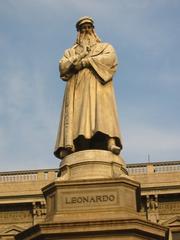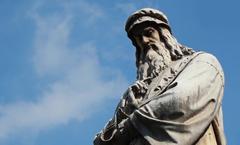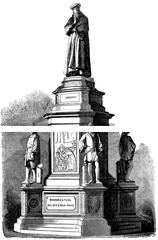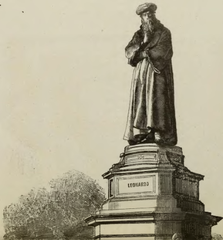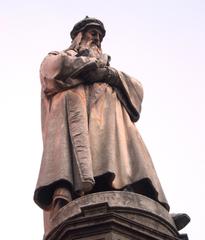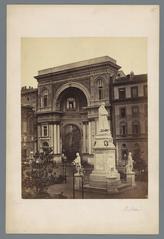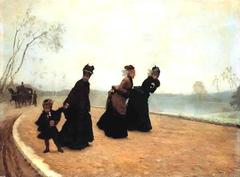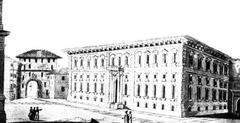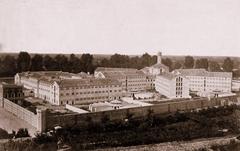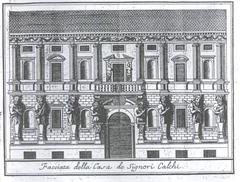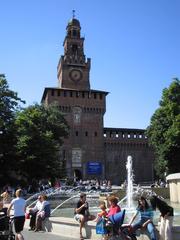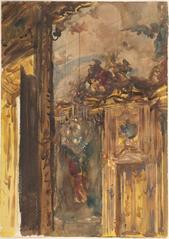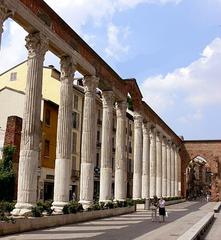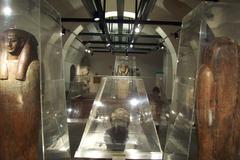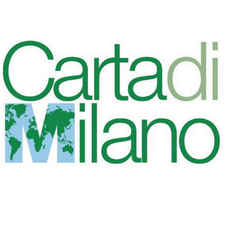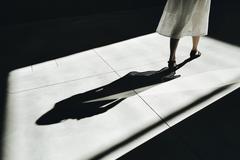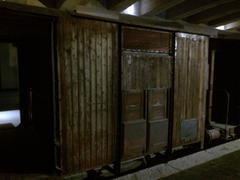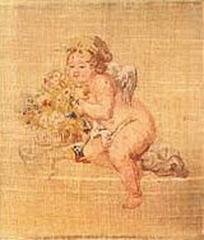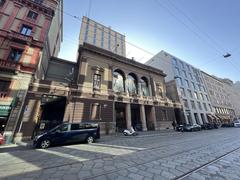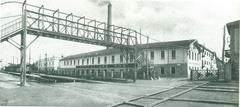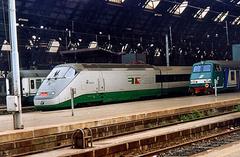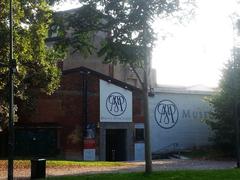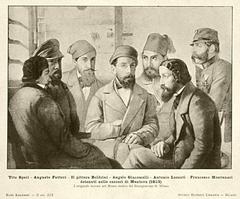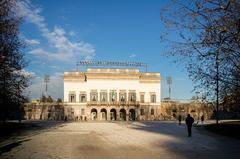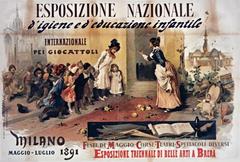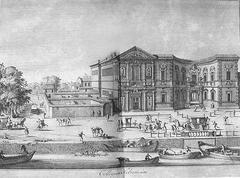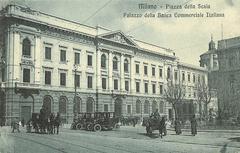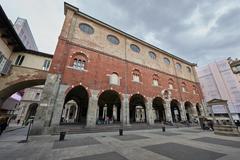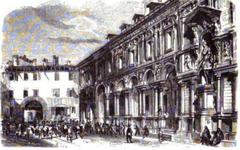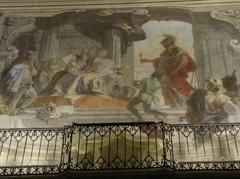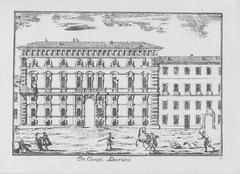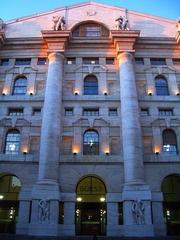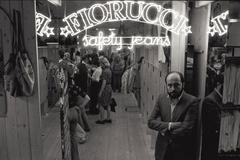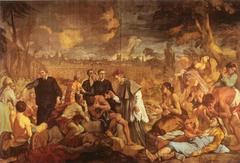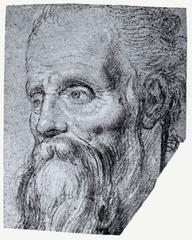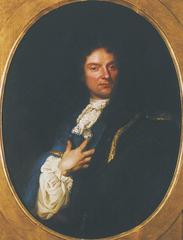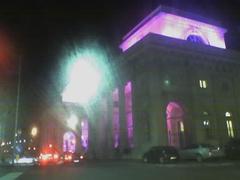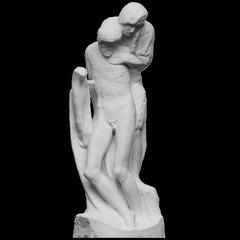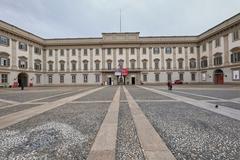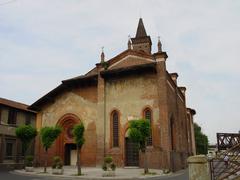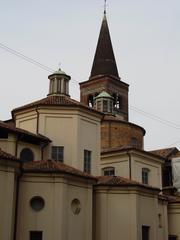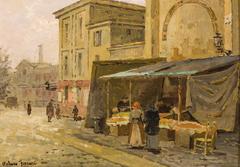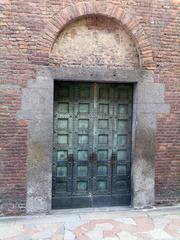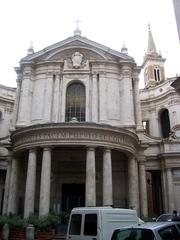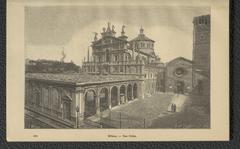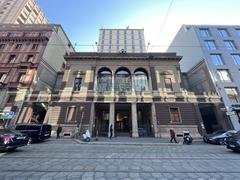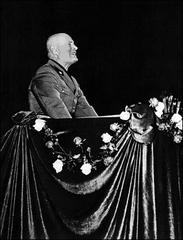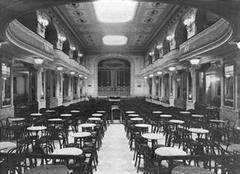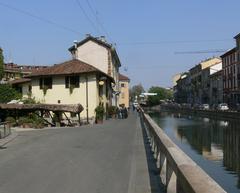
Visiting Statua di Leonardo da Vinci: History, Tickets, and Tips
Date: 20/07/2024
Introduction
The Statua di Leonardo da Vinci in Milan, Italy, is a monument of profound historical, artistic, and cultural significance. Located in the heart of Milan’s bustling Piazza della Scala, this statue pays homage to one of the greatest minds of the Renaissance, Leonardo da Vinci. Erected in 1872, it serves as a testament to Leonardo’s enduring influence on art, science, and engineering. This comprehensive guide will provide you with detailed insights into the statue’s rich history, cultural impact, and practical information for your visit. Whether you’re an art enthusiast, a history buff, or a curious traveler, this guide aims to enhance your experience and appreciation of one of Milan’s most iconic landmarks. (Viator, GetYourGuide)
Table of Contents
Visiting the Statua di Leonardo da Vinci in Milan - History, Tickets, and Tips
Introduction
The Statua di Leonardo da Vinci in Milan is not just a monument; it’s a tribute to one of the greatest minds in history. This article will cover everything you need to know about visiting this iconic statue, from its rich history to ticket information and travel tips.
History of the Statua di Leonardo da Vinci in Milan, Italy
Origins and Commissioning
The Statua di Leonardo da Vinci, located in Piazza della Scala in Milan, Italy, is a prominent monument dedicated to the renowned Renaissance polymath, Leonardo da Vinci. The statue was commissioned in the mid-19th century, a period marked by a resurgence of interest in Renaissance art and culture. The idea for the statue was proposed by the Accademia di Belle Arti di Brera, an influential art institution in Milan, which sought to honor Leonardo’s contributions to art, science, and engineering.
Design and Construction
The design of the statue was entrusted to the Italian sculptor Pietro Magni, who was known for his neoclassical style and meticulous attention to detail. Magni’s design was selected through a competitive process, reflecting the high esteem in which Leonardo was held. The statue was crafted from Carrara marble, a material renowned for its quality and association with classical sculpture.
The monument features Leonardo da Vinci standing atop a pedestal, with four of his most famous pupils—Cesare da Sesto, Giovanni Antonio Boltraffio, Marco d’Oggiono, and Andrea Solari—seated at the base. Each pupil is depicted with attributes that symbolize their contributions to the arts and sciences, underscoring Leonardo’s role as a mentor and teacher.
Inauguration
The statue was officially unveiled on April 20, 1872, in a grand ceremony attended by dignitaries, artists, and citizens of Milan. The unveiling was a significant cultural event, reflecting the city’s pride in its historical connection to Leonardo da Vinci. The statue’s location in Piazza della Scala, near the famous Teatro alla Scala opera house, further cemented its status as a cultural landmark.
Historical Context
The mid-19th century was a period of national unification and cultural revival in Italy. The commissioning of the Statua di Leonardo da Vinci was part of a broader effort to celebrate Italian heritage and the achievements of its historical figures. Leonardo, who spent a significant portion of his career in Milan, was an ideal figure to symbolize this cultural renaissance.
Restoration and Preservation
Over the years, the statue has undergone several restoration efforts to preserve its condition and ensure its longevity. The most recent restoration took place in 2011, funded by the City of Milan and private sponsors. This restoration involved cleaning the marble, repairing any damage, and applying protective treatments to prevent future deterioration. The careful preservation of the statue reflects its enduring significance as a cultural and historical monument.
Cultural Significance
The Statua di Leonardo da Vinci is more than just a tribute to an individual; it represents the enduring legacy of the Renaissance and the profound impact of Leonardo’s work on art, science, and technology. The statue serves as a reminder of Milan’s historical role as a center of artistic and intellectual activity, attracting visitors from around the world who come to pay homage to one of history’s greatest minds.
Influence on Milanese Identity
The presence of the statue in Milan has contributed to the city’s identity as a hub of creativity and innovation. Leonardo’s association with Milan, where he created some of his most famous works, including “The Last Supper,” has become a point of pride for the city’s residents. The statue is a focal point for cultural events, educational programs, and tourist activities, reinforcing Milan’s reputation as a city that values its artistic heritage.
Visitor Information
Ticket Information
Tickets to visit the Statua di Leonardo da Vinci are free, as it is an open-air monument accessible to the public at any time. However, guided tours may require a fee.
Opening Hours
The area around the statue is accessible 24/7, but for guided tours, it is best to check with local tour operators for their schedules.
Accessibility
The monument is situated in a pedestrian-friendly area, with ramps and pathways suitable for visitors with disabilities.
Travel Tips and Nearby Attractions
While visiting the Statua di Leonardo da Vinci, make sure to explore nearby attractions such as the Galleria Vittorio Emanuele II and the Duomo di Milano. These landmarks are within walking distance and offer a deeper insight into Milan’s rich cultural heritage.
Visitor Experience
Visitors to the Statua di Leonardo da Vinci can appreciate not only the artistic craftsmanship of the monument but also its historical and cultural context. The statue is situated in a bustling area of Milan, surrounded by other notable landmarks such as the Galleria Vittorio Emanuele II and the Duomo di Milano. This central location makes it easily accessible and a popular stop on walking tours of the city.
Educational Impact
The statue also serves an educational purpose, providing a tangible connection to Leonardo da Vinci’s life and work. Schools and universities often organize visits to the statue as part of their curriculum on Renaissance history and art. Informational plaques and guided tours offer insights into Leonardo’s contributions and the historical significance of the monument.
FAQ
- What are the visiting hours for the Statua di Leonardo da Vinci? “The statue is accessible 24/7, but guided tours have specific hours.”
- Do I need tickets to visit the Statua di Leonardo da Vinci? “No tickets are required to visit the statue itself, but guided tours may have a fee.”
Conclusion
The Statua di Leonardo da Vinci in Milan stands as a testament to the enduring legacy of one of history’s most influential figures. Its rich history, cultural significance, and educational value make it a must-visit landmark for anyone interested in the Renaissance and the profound impact of Leonardo da Vinci’s work. The statue not only honors the past but also inspires future generations to appreciate and continue the pursuit of knowledge and creativity.
Visiting the Statua di Leonardo da Vinci in Milan - History, Tickets, and Travel Tips
Introduction
The Statua di Leonardo da Vinci in Milan, Italy, is a monument of profound historical, artistic, and cultural significance. This guide provides comprehensive information about its history, visiting hours, ticket prices, and travel tips to ensure a memorable visit.
Historical Context
The Statua di Leonardo da Vinci was erected in 1872 to commemorate one of the most influential figures of the Renaissance. Leonardo spent a significant portion of his career in Milan under the patronage of Ludovico Sforza, the Duke of Milan. During this period, he created some of his most renowned works, including “The Last Supper” and numerous scientific and engineering studies.
The statue stands in Piazza della Scala, a prominent location that underscores its importance. Designed by sculptor Pietro Magni, the statue reflects Leonardo’s intellectual and artistic prowess.
Artistic Significance
Pietro Magni’s design captures Leonardo in a contemplative pose, symbolizing his endless quest for knowledge and innovation. The statue is surrounded by four of Leonardo’s most famous pupils - Cesare da Sesto, Giovanni Antonio Boltraffio, Marco d’Oggiono, and Andrea Solari. This arrangement highlights Leonardo’s role as a mentor and his influence on future generations of artists.
Magni’s attention to detail, from the textures of Leonardo’s robes to the lifelike expressions of the pupils, demonstrates the high level of craftsmanship involved. The statue serves as a visual representation of the Renaissance ideals of humanism and intellectual pursuit.
Cultural Impact
The Statua di Leonardo da Vinci is a focal point for both locals and tourists, symbolizing Milan’s rich artistic heritage. It often serves as a starting point for cultural tours, linking visitors to other significant sites such as the Leonardo da Vinci Museum of Science and Technology and the Santa Maria delle Grazie, where “The Last Supper” is housed.
The statue is a central feature during the annual Milan Design Week, serving as a backdrop for exhibitions and installations. This ongoing engagement with contemporary culture ensures that Leonardo’s legacy remains relevant and inspiring.
Tickets and Visiting Hours
The Statua di Leonardo da Vinci is located in a public square, making it accessible 24/7 without any admission fee. However, guided tours that include the statue and other Leonardo-related sites may have specific ticket prices and schedules. It is advisable to check with local tour operators for the most up-to-date information.
Travel Tips
- **Best Time to Visit - ** Early morning or late afternoon when the square is less crowded.
- **Photography - ** The statue provides a picturesque backdrop, especially when lit up at night. Don’t forget your camera!
- **Nearby Attractions - ** Include the Teatro alla Scala, Galleria Vittorio Emanuele II, and Duomo di Milano.
- **Accessibility - ** The square is wheelchair accessible, making it convenient for all visitors.
Educational Value
The statue serves as an educational tool, offering insights into Leonardo’s life and works. Schools and universities often organize field trips to the statue, providing students with a tangible connection to their studies of the Renaissance. Informational plaques around the statue offer historical context and details about Leonardo’s contributions to various fields.
Moreover, the statue is part of the Leonardo da Vinci Itinerary, a guided tour that takes visitors through key locations associated with Leonardo’s life in Milan. This itinerary includes stops at the Ambrosiana Library, where Leonardo’s Codex Atlanticus is kept, and the Sforza Castle, which houses several of his works.
Symbol of Innovation
Leonardo da Vinci is often hailed as the epitome of the Renaissance man, excelling in diverse fields such as art, science, engineering, and anatomy. The Statua di Leonardo da Vinci symbolizes this spirit of innovation and interdisciplinary exploration. It serves as an inspiration for contemporary thinkers and creators, reminding them of the importance of curiosity and the pursuit of knowledge.
In recent years, the statue has become a symbol for various innovation-driven events in Milan, such as the Milan Innovation District (MIND) Expo. This modern reinterpretation of Leonardo’s legacy ensures that his spirit of innovation continues to inspire future generations.
Preservation Efforts
Preserving the Statua di Leonardo da Vinci is a priority for the city of Milan. Over the years, the statue has undergone several restoration projects to maintain its structural integrity and aesthetic appeal. These efforts are crucial in ensuring that the monument remains a lasting tribute to Leonardo’s legacy.
In 2019, a significant restoration project was undertaken to clean and repair the statue. This involved removing accumulated dirt and pollutants, repairing any structural damage, and applying protective coatings to prevent future deterioration.
Conclusion
The Statua di Leonardo da Vinci in Milan is a monument of immense historical, artistic, and cultural significance. It stands as a testament to Leonardo’s enduring legacy and serves as a source of inspiration and education for people around the world. Through ongoing preservation efforts and its role in contemporary cultural events, the statue continues to honor the memory of one of history’s greatest minds.
Frequently Asked Questions (FAQ)
- What are the visiting hours for the Statua di Leonardo da Vinci? The statue is accessible 24/7 as it is located in a public square.
- How much are the tickets for the Statua di Leonardo da Vinci? There is no admission fee to view the statue, but guided tours that include it may have specific ticket prices.
- What is the best time to visit the Statua di Leonardo da Vinci? Early morning or late afternoon to avoid crowds.
- Are there any nearby attractions? Yes, including the Teatro alla Scala, Galleria Vittorio Emanuele II, and Duomo di Milano.
Visiting the Statua di Leonardo da Vinci in Milan - Tips, Tickets, and More
Visiting the Statua di Leonardo da Vinci in Milan - Tips, Tickets, and More
Introduction
Situated in one of Milan’s most iconic squares, the Statua di Leonardo da Vinci is a must-see for visitors interested in art and history. This guide will provide you with essential tips, ticket information, and advice to make the most of your visit.
Location and Accessibility
The Statua di Leonardo da Vinci is located in Piazza della Scala, a central hub in Milan. The nearest metro station is Duomo (Lines M1 and M3), a short walk away. Trams 1, 2, 12, 14, and 16 also stop near the square, making it easily accessible by public transport.
Best Time to Visit
To avoid the crowds, visit early in the morning or late in the afternoon. The statue is outdoors, so weather can impact your experience. Spring (April to June) and autumn (September to October) are ideal for mild and pleasant weather.
Ticket Information
The Statua di Leonardo da Vinci is accessible to the public free of charge. No tickets are required. However, if you plan to join a guided tour that includes the statue, ticket prices can vary. Websites like [Viator](https - //www.viator.com/Milan-attractions/Leonardo-da-Vinci-Statue/d512-a17391) and [GetYourGuide](https - //www.getyourguide.com/milan-l139/leonardo-da-vinci-statue-tours-tc202/) offer various options.
Visiting Hours
The statue is located in a public square and is accessible 24/7. However, guided tours and nearby attractions may have specific opening hours, so check in advance.
Guided Tours
For an enriching experience, consider a guided tour. Many tours include the Statua di Leonardo da Vinci and other nearby attractions such as the Teatro alla Scala and the Galleria Vittorio Emanuele II. These tours provide historical context and interesting anecdotes that you might miss otherwise.
Photography Tips
Capture the best shots with these photography tips -
- Lighting - Early morning or late afternoon light is best.
- Angles - Experiment with different angles to capture the statue and its surroundings. A low-angle shot can make the statue appear more imposing.
- Details - Zoom in on intricate details like Leonardo’s face and pedestal inscriptions.
Nearby Attractions
- Teatro alla Scala - One of the world’s most famous opera houses, located steps away from the statue. ([Teatro alla Scala](https - //www.teatroallascala.org/en/index.html))
- Galleria Vittorio Emanuele II - A historic shopping arcade known for its stunning architecture and luxury shops. ([Galleria Vittorio Emanuele II](https - //www.yesmilano.it/en/see-and-do/venues/galleria-vittorio-emanuele-ii))
- Duomo di Milano - Milan’s iconic cathedral, a short walk from the statue. ([Duomo di Milano](https - //www.duomomilano.it/en/))
Dining Options
After visiting the statue, consider these dining options around Piazza della Scala -
- Ristorante Teatro alla Scala Il Marchesino - Offers fine dining with a menu inspired by traditional Italian cuisine. ([Il Marchesino](https - //www.marchesinorestaurant.it/))
- Caffè Trussardi - A chic café perfect for a quick coffee or light meal. ([Caffè Trussardi](https - //www.trussardiallascala.com/))
- Luini Panzerotti - Famous for its panzerotti, located near the Duomo. ([Luini](https - //www.luini.it/))
Safety Tips
Milan is generally safe, but take some precautions -
- Pickpockets - Be mindful of your belongings in crowded areas.
- Weather - Check the forecast and dress accordingly.
- Local Laws - Familiarize yourself with local laws and customs.
Accessibility for Disabled Visitors
The area around the statue is generally accessible for visitors with disabilities. The square is flat and paved, making it easy to navigate with a wheelchair or mobility scooter. Check the latest accessibility information on websites like [Milan Tourism](https - //www.yesmilano.it/en).
Souvenirs and Shopping
Several souvenir shops in the vicinity offer items like postcards, magnets, and replicas of Leonardo da Vinci’s inventions. The nearby Galleria Vittorio Emanuele II has high-end boutiques for luxury shopping.
Language Tips
While many people in Milan speak English, knowing a few Italian phrases can enhance your experience -
- Hello - Ciao
- Thank you - Grazie
- Please - Per favore
- Excuse me - Mi scusi
Emergency Contacts
In case of emergencies -
- Emergency Services - 112
- Tourist Police - 113
- Medical Emergencies - 118
FAQ
What are the visiting hours for the Statua di Leonardo da Vinci? The statue is accessible 24/7 as it is located in a public square.
Are there guided tours available? Yes, websites like Viator and GetYourGuide offer various guided tour options.
Final Thoughts
Visiting the Statua di Leonardo da Vinci is a must for anyone interested in art and history. With these tips, you’re well-equipped to make the most of your visit. For more travel tips and updates, follow us on social media and check out our other related posts.
Conclusion
In conclusion, the Statua di Leonardo da Vinci stands not only as a tribute to one of history’s most influential figures but also as a beacon of Milan’s rich cultural and artistic heritage. Its strategic location in Piazza della Scala makes it a pivotal point for cultural tours and educational visits. The statue’s intricate design by Pietro Magni, coupled with its historical and cultural significance, offers a deep dive into the Renaissance era and Leonardo’s multifaceted genius. Whether you’re exploring nearby attractions like the Teatro alla Scala or the Galleria Vittorio Emanuele II, or simply soaking in the ambiance of Milan, the statue is a must-visit landmark that promises to enrich your understanding of Leonardo da Vinci’s legacy. With free access and 24/7 availability, it remains an accessible and inspiring destination for all visitors. (Teatro alla Scala, Galleria Vittorio Emanuele II)
References
- Visiting the Statua di Leonardo da Vinci in Milan - History, Tickets, and Tips, 2024, Viator
- Visiting the Statua di Leonardo da Vinci in Milan - History, Tickets, and Travel Tips, 2024, GetYourGuide

